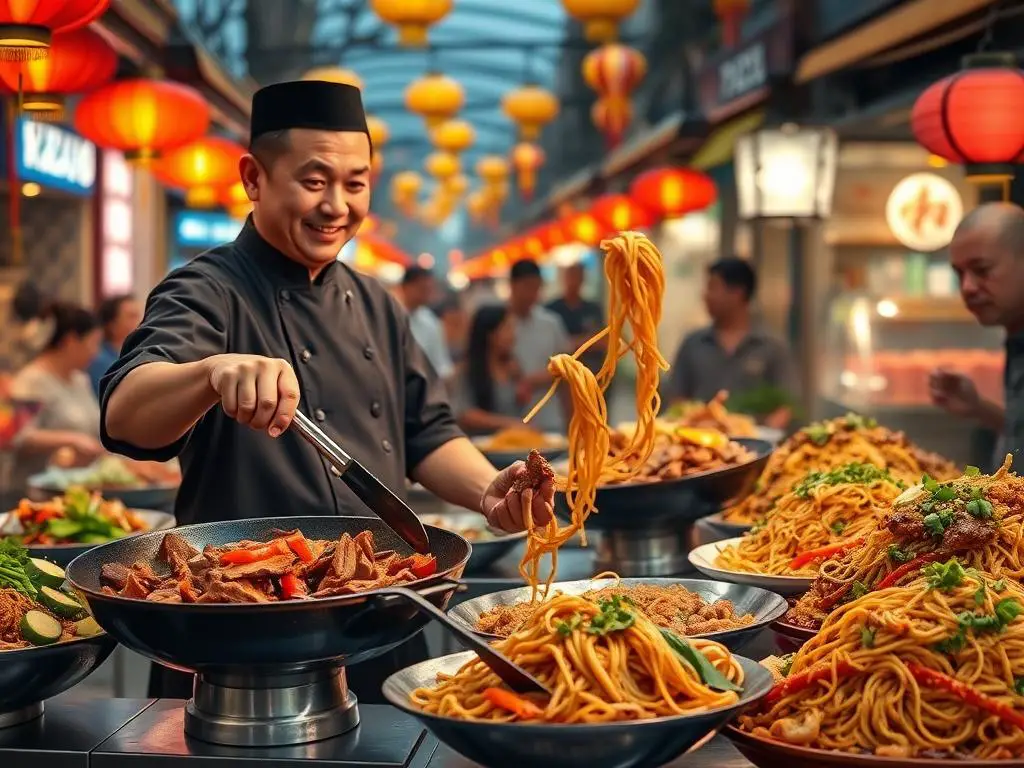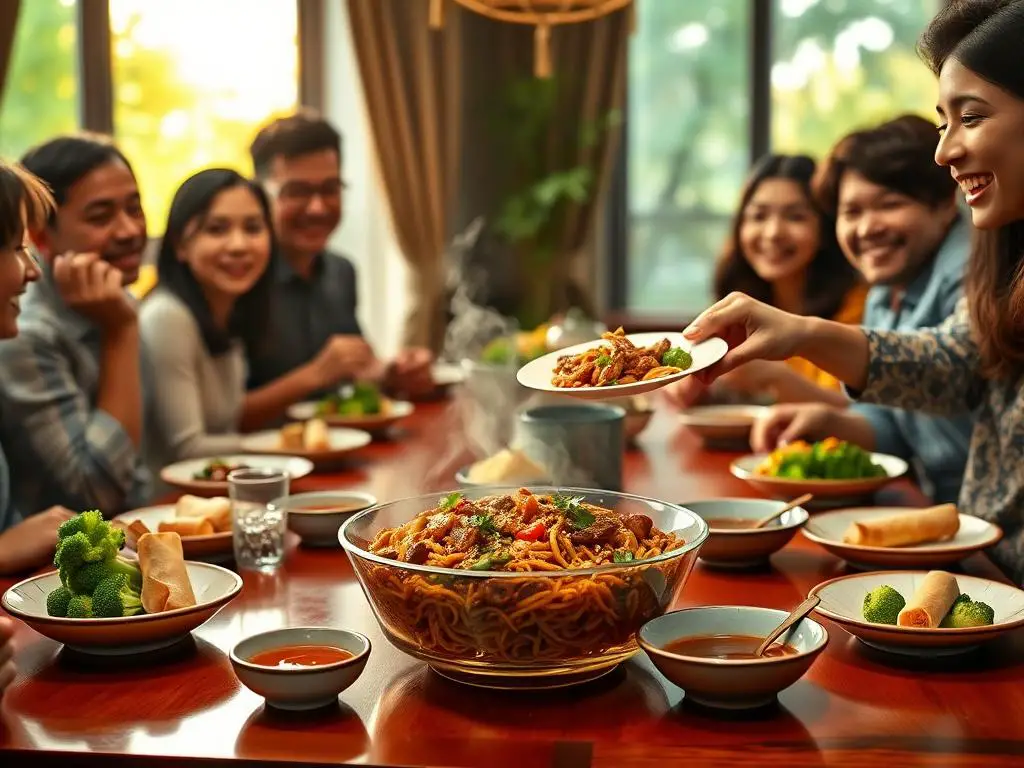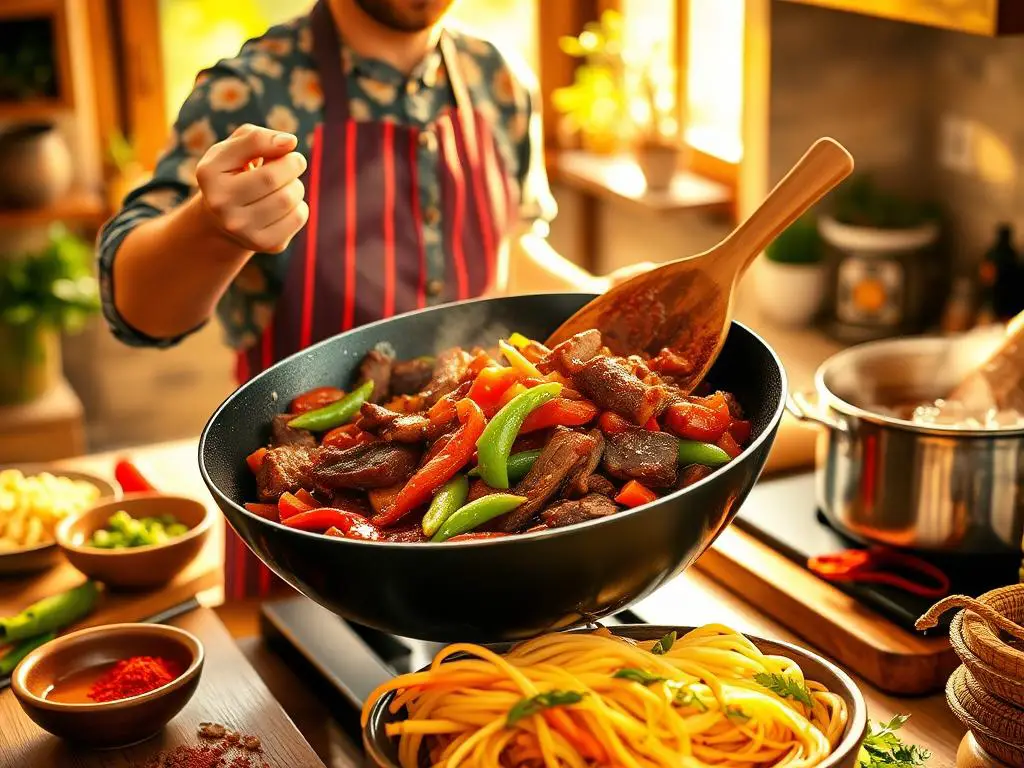Flavorful Beef Chow Mein is a delicious stir-fry dish that combines tender beef strips with crisp vegetables and savory noodles. The dish is enhanced with a flavorful sauce made from soy sauce, garlic, and ginger, providing a perfect balance of taste. Quick to prepare, it makes for an ideal weeknight meal that satisfies cravings for Asian cuisine.
Beef Chow Mein is a beloved dish in many households, celebrated for its savory flavors, delightful textures, and the comforting embrace of stir-fried noodles. Originating from Chinese cuisine, this dish has transcended borders and has been adapted in various forms around the world. Whether you’re enjoying it at a local restaurant or preparing it at home, Beef Chow Mein offers a delicious combination of tender beef, crisp vegetables, and delectable noodles, all tossed in a flavorful sauce that brings everything together. In this article, we will explore the origins of this dish, its essential ingredients, and a simple recipe that you can try at home.
“`html
| Feature | Details |
|---|---|
| Primary Ingredient | Beef |
| Cuisine Type | Chinese |
| Main Dish Type | Noodle Dish |
| Flavor Profile | Savory and Umami |
| Cooking Method | Stir-frying |
| Common Vegetables | Bell Peppers, Carrots, Bean Sprouts |
| Serving Style | Hot and Fresh |
“`
The Origins of Beef Chow Mein

The term “Chow Mein” translates to “stir-fried noodles” in Mandarin, and this dish has roots that stretch back centuries in Chinese culinary history. It is thought to have originated from the Taishan region of Guangdong province, where immigrants brought the dish to the United States in the late 19th century. As it settled into American culture, Chow Mein evolved and diversified, incorporating local ingredients and preferences.
In its traditional form, Chow Mein consists of thin egg noodles stir-fried with a variety of meats and vegetables. The beef variant is particularly popular, as it balances well with the chewy texture of the noodles and the vibrant crunch of vegetables. Over time, many regions have developed their own versions of Beef Chow Mein, with varying sauces and cooking techniques. Nonetheless, the core elements remain the same: a harmonious blend of flavors and textures that pleases the palate.
Essential Ingredients for Flavorful Beef Chow Mein

Creating a mouthwatering Beef Chow Mein at home requires a careful selection of ingredients. While the recipe can be customized to your taste, here are the essential components that contribute to its signature flavor:
- Beef: Thinly sliced flank steak or sirloin is ideal for this dish. The meat should be tender and marinated briefly to enhance its flavor and texture.
- Noodles: Chow Mein noodles, which are typically egg noodles, are the star of the dish. They can be found in most Asian grocery stores, but you can also use other types of noodles like rice noodles if you prefer.
- Vegetables: A colorful mix of vegetables is crucial for both flavor and nutrition. Common choices include bell peppers, carrots, snow peas, and cabbage. Feel free to experiment with any vegetables you enjoy.
- Aromatics: Fresh garlic and ginger are essential for building a flavor base. They add depth and a fragrant quality to the dish.
- Sauce: A blend of soy sauce, oyster sauce, and sesame oil provides a rich umami flavor. You can adjust the ratios according to your taste preferences.
- Seasonings: A dash of salt and pepper, along with a sprinkle of green onions for garnish, rounds out the flavor profile.
Preparing Your Beef Chow Mein: Step-by-Step Guide

Now that we’ve gathered our ingredients, let’s dive into the preparation process. This Beef Chow Mein recipe is designed to be straightforward, making it perfect for both beginners and seasoned cooks alike.
Step 1: Marinate the Beef
Start by marinating the thinly sliced beef in a mixture of soy sauce, cornstarch, and a bit of sesame oil for about 20 minutes. This step not only infuses the meat with flavor but also helps to tenderize it, ensuring every bite is juicy and delicious.
Step 2: Prepare the Noodles
While the beef is marinating, cook the Chow Mein noodles according to the package instructions. Drain and rinse them under cold water to stop the cooking process. This will prevent them from becoming mushy during the stir-frying.
Step 3: Stir-Fry the Beef
In a large skillet or wok, heat a tablespoon of oil over medium-high heat. Once the oil is hot, add the marinated beef, spreading it out evenly in the pan. Stir-fry for about 2-3 minutes until the beef is browned and cooked through. Remove the beef from the pan and set it aside.
Step 4: Cook the Vegetables
In the same pan, add another tablespoon of oil if needed and toss in the minced garlic and ginger. Sauté for about 30 seconds until fragrant, then add your choice of vegetables. Stir-fry until they are tender-crisp, usually around 3-5 minutes.
Step 5: Combine and Serve
Add the cooked noodles and beef back into the pan. Pour the sauce mixture over everything, tossing to combine thoroughly. Cook for an additional minute or two, allowing the sauce to coat the ingredients evenly. Once heated through, serve your Beef Chow Mein hot, garnished with sliced green onions.
Variations of Beef Chow Mein

While the classic Beef Chow Mein is a delightful dish on its own, there are numerous variations that you can explore to keep your meals exciting. Each variation incorporates different ingredients and flavors, reflecting personal tastes and local culinary traditions. Here are some popular alternatives to consider:
- Vegetable Chow Mein: For those who prefer a meatless option, Vegetable Chow Mein is a fantastic choice. It highlights a mix of seasonal vegetables such as broccoli, mushrooms, and baby corn, providing a colorful and healthy dish. You can still use the same savory sauce to tie everything together.
- Chicken Chow Mein: Chicken is a popular substitute for beef in Chow Mein recipes. Using thinly sliced chicken breast or thighs adds a light, tender protein that pairs wonderfully with the noodles and vegetables. The cooking method remains the same, making it an easy switch.
- Seafood Chow Mein: For a seafood twist, consider shrimp or scallops as the main protein. The delicate flavors of seafood complement the stir-fried vegetables and noodles beautifully, creating a dish that is both elegant and satisfying.
- Spicy Beef Chow Mein: If you’re a fan of heat, adding chili paste or fresh chili peppers can elevate your Beef Chow Mein to a whole new level. Incorporating these ingredients will provide a spicy kick that balances the umami of the sauce.
- Beef and Broccoli Chow Mein: This version combines the classic Chow Mein elements with tender broccoli florets. The beef is stir-fried with the broccoli, providing a hearty and nutritious meal that is both filling and flavorful.
Serving Suggestions

To enhance your Beef Chow Mein experience, consider some creative serving suggestions that can elevate your meal:
- Pair with Spring Rolls: Serve your Beef Chow Mein with crispy spring rolls on the side. The crunchy texture of the rolls complements the soft noodles and adds an extra layer of flavor.
- Top with Fried Egg: For a rich and indulgent touch, consider adding a fried egg on top of your Beef Chow Mein. The runny yolk creates a creamy sauce that seamlessly blends with the dish.
- Serve with Hot Sauce: If you enjoy spicy food, provide a side of chili oil or hot sauce for guests to drizzle over their plates. This allows everyone to customize their spice level.
- Garnish with Fresh Herbs: A sprinkle of fresh cilantro or basil can brighten the dish and add a burst of flavor. This also enhances the visual appeal of your meal.
- Pair with Tea: A hot cup of green or jasmine tea is a perfect accompaniment to Beef Chow Mein, providing a refreshing contrast to the savory flavors of the dish.
Tips for the Perfect Beef Chow Mein

To ensure that your Beef Chow Mein turns out perfectly every time, here are some helpful tips to keep in mind:
- High Heat is Key: Stir-frying requires high heat to achieve that characteristic smoky flavor, known as “wok hei.” Make sure your pan or wok is hot before adding ingredients, and work in batches if necessary to prevent overcrowding.
- Prep Ahead: To make the cooking process smoother, have all your ingredients prepped and ready to go before you start cooking. This includes slicing the beef, chopping vegetables, and mixing the sauce.
- Don’t Overcook the Vegetables: Aim for tender-crisp vegetables. Overcooked vegetables can lose their vibrant color and crunch, so be sure to stir-fry them just until they are bright and slightly tender.
- Adjust Sauce to Taste: Everyone has different preferences when it comes to flavor. Taste the sauce as you go and adjust the ingredients to suit your palate, whether that means adding more soy sauce for saltiness or a splash of vinegar for tang.
- Let the Noodles Sit: Once cooked, allow the noodles to sit for a few minutes before adding them to the stir-fry. This helps them firm up slightly, making them less likely to stick together during cooking.
Storing Leftovers

If you find yourself with leftover Beef Chow Mein, storing it properly is essential to maintain its flavor and texture. Here are some guidelines for best practices:
- Cool Before Storing: Allow your Beef Chow Mein to cool to room temperature before transferring it to an airtight container. This helps to prevent condensation, which can lead to sogginess.
- Refrigerate: Store your leftovers in the refrigerator for up to 3-4 days. Be sure to label the container with the date to keep track of freshness.
- Reheat Gently: When you’re ready to enjoy your leftovers, reheat them gently in a skillet over medium heat, adding a splash of water or soy sauce to keep the noodles moist. Stir frequently to ensure even heating.
With these variations, serving suggestions, and tips at your disposal, you are well on your way to mastering the art of Beef Chow Mein, whether you’re whipping it up for a casual weeknight dinner or impressing guests at a gathering. Enjoy the delightful balance of flavors and textures as you share this beloved dish with family and friends!
Health Benefits of Beef Chow Mein
While Beef Chow Mein is often enjoyed for its rich flavors and satisfying textures, it also offers a range of health benefits when prepared with fresh ingredients. Understanding these benefits can enhance your appreciation for this dish and encourage healthier cooking practices. Here are some key health advantages of Beef Chow Mein:
- Protein-Rich: Beef is an excellent source of high-quality protein, which is essential for muscle growth and repair. It also plays a vital role in various bodily functions, including hormone production and immune system support. By incorporating lean cuts of beef into your Chow Mein, you can enjoy a protein-packed meal that keeps you feeling full and energized.
- Vegetable Power: The colorful mix of vegetables in Beef Chow Mein not only adds flavor but also boosts nutritional content. Vegetables are rich in vitamins, minerals, and antioxidants, which contribute to overall health. For example, bell peppers are high in vitamin C, while carrots provide beta-carotene, promoting healthy skin and vision.
- Whole Grains Option: If you choose to use whole wheat Chow Mein noodles or substitute them with whole grain rice noodles, you’ll increase the fiber content of your meal. Fiber is crucial for digestive health, helping to regulate blood sugar levels and keep you feeling satiated longer.
- Low in Saturated Fats: By selecting lean cuts of beef and opting for a minimal amount of oil during cooking, you can create a dish that is lower in saturated fats. This choice is beneficial for heart health, as it can help maintain healthy cholesterol levels.
- Customizable for Dietary Needs: Beef Chow Mein is highly customizable, making it easy to accommodate various dietary preferences. Whether you’re looking to reduce calories, increase vegetable intake, or substitute protein sources, this dish can be adjusted to fit your nutritional goals.
Pairing Wines with Beef Chow Mein
Enhancing your dining experience can be as simple as choosing the right wine to accompany your Beef Chow Mein. The right pairing can elevate the flavors of the dish and create a harmonious meal. Here are some wine options that complement the savory notes and textures of Beef Chow Mein:
- Pinot Noir: This light to medium-bodied red wine is characterized by its fruity flavors and smooth tannins, making it a versatile pairing for Beef Chow Mein. The wine’s acidity helps balance the richness of the beef, while its berry notes can enhance the flavors of the vegetables.
- Sauvignon Blanc: If you prefer white wine, Sauvignon Blanc is an excellent choice. Its crisp acidity and herbal notes can complement the freshness of the vegetables in the dish, creating a refreshing contrast to the savory flavors.
- Chardonnay: For a richer option, consider an oaked Chardonnay. The buttery texture and flavors of vanilla and oak can harmonize beautifully with the umami of the sauce, enhancing your overall dining experience.
- Rose: A dry rosé offers a great balance of fruitiness and acidity, making it a delightful pairing for Beef Chow Mein. It’s an ideal option for those who enjoy a lighter wine without sacrificing flavor.
Cooking Equipment for Beef Chow Mein
To achieve the best results when making Beef Chow Mein, having the right cooking equipment can make a significant difference. Here’s a list of essential tools that will help you prepare this dish with ease:
- Wok: A traditional wok is ideal for stir-frying, as its high sides allow for tossing and turning ingredients without spilling. The shape also helps distribute heat evenly, creating that sought-after “wok hei” flavor.
- Spatula or Wooden Spoon: A sturdy spatula or wooden spoon is crucial for stirring and flipping the ingredients in the wok. A wide spatula can help lift the noodles and beef without breaking them apart.
- Measuring Cups and Spoons: Precision is important when measuring sauces and seasonings. Having measuring cups and spoons on hand ensures that you replicate your favorite flavors each time you cook.
- Cutting Board and Knife: A good quality cutting board and knife are essential for prepping vegetables and slicing beef. Make sure your knife is sharp to make clean cuts, which helps maintain the texture of your ingredients.
- Colander: A colander is useful for draining the noodles after cooking. Rinsing them under cold water will stop the cooking process and prevent them from becoming soggy.
Beef Chow Mein Around the World
While Beef Chow Mein is rooted in Chinese cuisine, it has been embraced and adapted globally, resulting in a variety of regional interpretations. Here are some noteworthy adaptations from around the world:
- American-Chinese Style: In the United States, Beef Chow Mein often features crispy noodles served with a stir-fry of beef and vegetables. The sauce tends to be sweeter and thicker than traditional versions, reflecting the American palate.
- Indo-Chinese Cuisine: In India, Beef Chow Mein is influenced by local spices and flavors. The dish may be prepared with a spicy chili sauce and additional ingredients like bell peppers and onions, creating a unique fusion of tastes.
- Filipino Pancit: Similar to Chow Mein, Pancit is a traditional Filipino noodle dish that incorporates beef, vegetables, and a variety of seasonings. The preparation may differ slightly, and it often includes soy sauce and lemon for added tang.
- Malaysian Mee Goreng: In Malaysia, Beef Chow Mein has evolved into Mee Goreng, a spicy stir-fried noodle dish often cooked with soy sauce, chili, and a variety of vegetables, giving it a distinct flavor profile.
